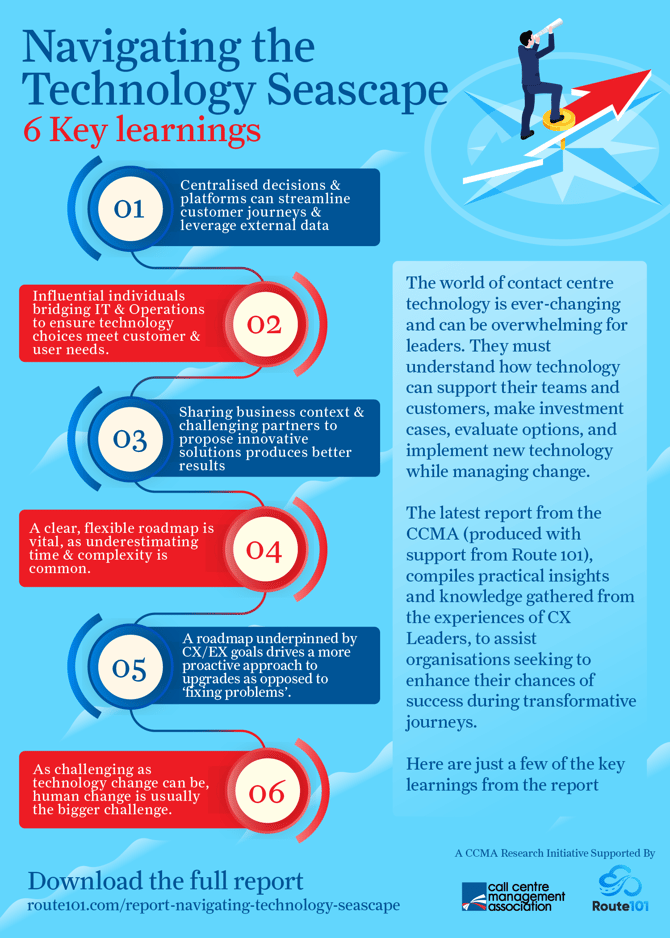The rapid pace of technological change can be overwhelming for contact centre leaders, who must navigate a complex seascape of options to find the right technology to support their teams and customers. Fortunately, a new report from the CCMA (produced with support from Route 101) has compiled practical insights and knowledge from CX leaders to help organisations enhance their chances of success during transformative journeys.
Within the report, there are 16 essential insights to consider and in this blog we will focus on 6 of those concepts to assist you in navigating your transformational journey.
-
Centralised decisions and platforms can streamline customer journeys and leverage external data and analytics.
By centralising decisions and platforms, organisations can optimise the customer journey. This can ensure consistency across all touchpoints and reduce the likelihood of confusion or conflicting messages for the customer. It also allows the use of external data and analytics to gain insights into customer preferences and behaviours leading to more targeted support. This approach ultimately improves the customer experience and increases satisfaction and loyalty.
-
Influential individuals bridging IT and Operations environments ensure technology choices meet customer and user needs.
These individuals bring together different perspectives to identify solutions that meet the requirements of all stakeholders. By doing so, they ensure that the technology choices made are relevant, effective, and contribute to a better customer experience. Ultimately, this approach leads to increased user adoption, satisfaction, and loyalty.
-
Sharing business context & challenging partners to propose innovative solutions can produce better results
Sharing business context ensures that partners have a clear understanding of business goals and objectives while encouraging them to propose innovative solutions can lead to out-of-the-box thinking and new approaches. This collaborative approach helps identify opportunities to improve processes and increase efficiency, resulting in better outcomes for the organisation and its customers.
-
A clear, flexible roadmap is vital for any implementation, as underestimating time and complexity is common.
Without a well-defined roadmap, it's easy to underestimate the time and complexity involved in implementing new technology, leading to project delays, increased costs, and even failure. A clear plan sets realistic timelines, identifies potential roadblocks and outlines milestones, enabling teams to manage change effectively. Having wriggle room built into the plan is crucial to accommodate unforeseen challenges and pivot as needed.
-
A roadmap underpinned by CX/EX goals drives a more proactive approach to upgrades as opposed to ‘fixing problems’.
Rather than reacting to problems as they arise, a roadmap that prioritises CX/EX goals enables organisations to proactively identify opportunities to improve the customer or employee experience. This approach promotes continuous improvement, with technology upgrades being viewed as a means of enhancing the overall experience, rather than merely fixing problems. By taking a proactive approach, organisations can stay ahead of the curve and improve satisfaction, loyalty, and retention.
-
As challenging as technology change can be, human change is usually the bigger challenge.
Implementing new technology can involve significant changes to workflows, processes, and systems, which can create resistance and pushback from employees who are used to working in a certain way. Overcoming this resistance requires strong leadership, effective communication, and a focus on the human element of change. This includes providing adequate training and support, involving employees in the change process, and addressing concerns and feedback. By managing the human element of change effectively, organisations can maximise adoption, minimise disruption and ensure successful technology implementation.
Navigating the technology seascape can be daunting for contact centre leaders, but the key learnings from the CCMA report provide practical insights and knowledge to enhance their chances of success during transformative journeys. With these key learnings in mind, contact centre leaders can confidently steer their organisations towards successful technology implementation and transformation.
To see all 16 key learnings, download the full report now




